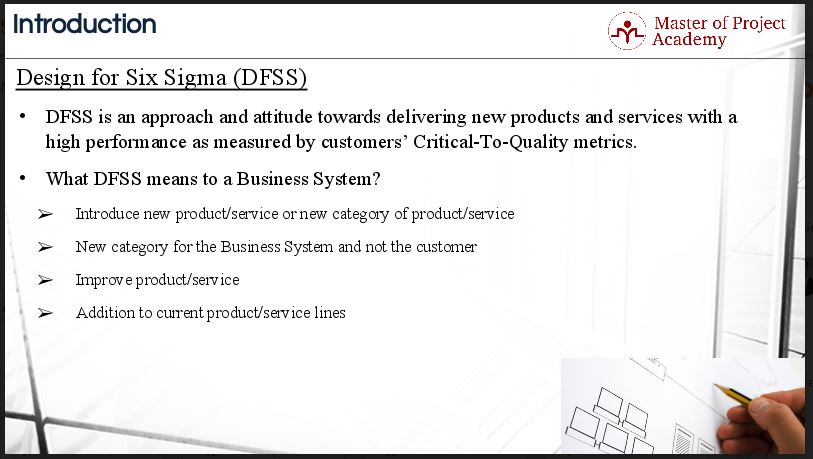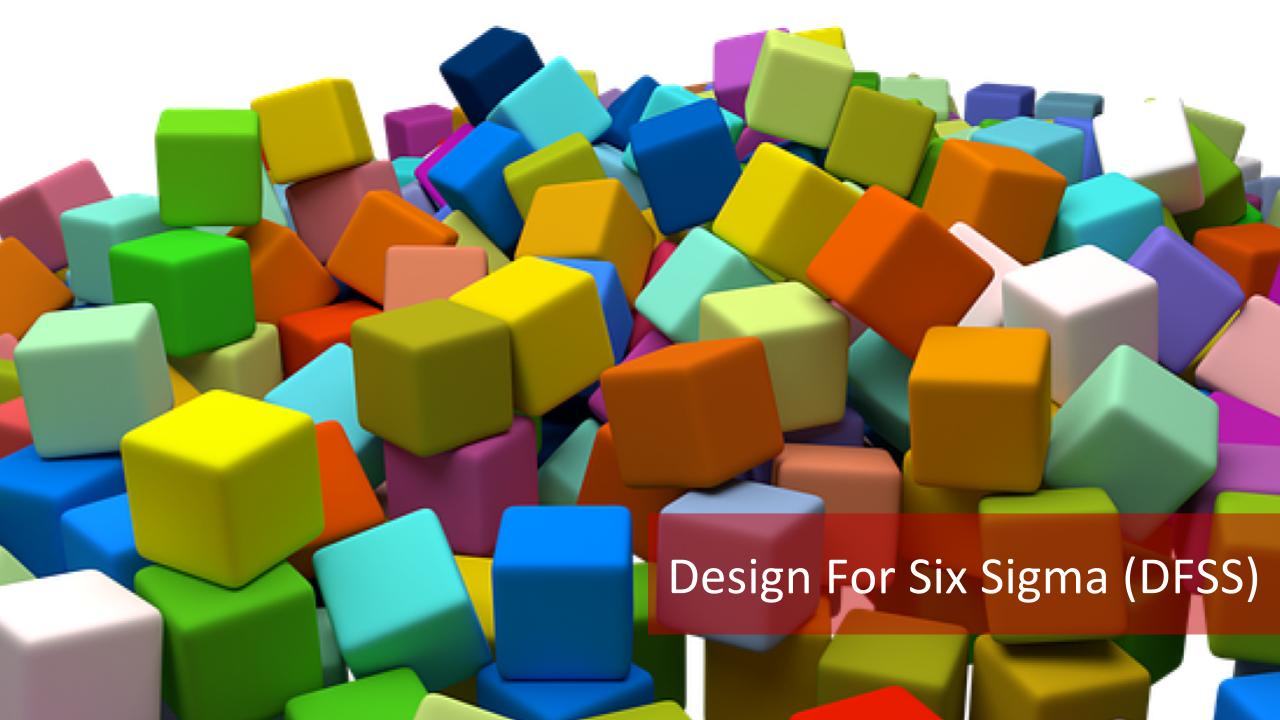When someone says Six Sigma, we immediately think about the DMAIC process for problem-solving. We think about processes with problems that cause them to deliver products or services with too much variation. We think about Green Belt training. This is briefly what is taught in a free Six Sigma Green Belt certification training. However, there is another angle to Six Sigma: DFSS. Sometimes a process needs to be designed from scratch.
Attend our 100% Online & Self-Paced Free Six Sigma Training.
Now you may ask yourself, why design a process that will have a lot of variation in its output? You are right in asking that question, and that is exactly what Design for Six Sigma or DFSS is for. DFSS is the Six Sigma way of designing a process first time right to have as little variation i.e. defects and defectives as possible. It is an alternative Six Sigma approach, but it still follows the main Six Sigma principles.
What is DFSS?
Let’s talk about the DFSS approach to designing a process. Design for Six Sigma is an approach to designing or redesigning a product and/or services to meet or exceed customer requirements and expectations. DFSS is an enhancement to your new product development process, not a replacement for it. A documented, well-understood and useful new product development process are fundamental to a successful DFSS program. Unlike the DMAIC (Define-Measure-Analyze-Improve-Control) methodology of Six Sigma, DFFS is not a universal process. Each company or organization will use Design for Six Sigma differently. They will implement DFSS according to their business needs, structure, industry, and culture. Design for Six Sigma is an approach rather than a method.
What can be designed with DFSS?
Products, services, and processes can be designed with DFSS. Here is what is mostly designed with Design for Six Sigma:
- New products/services
- New process for a new product/service
- Redesign of existing product/service to meet customer requirement
- Redesign of existing product/service process
Why DFSS?
DFSS ensures that the Product/Service meets customer requirement and that the process of this Product/Service is already at Six Sigma level. The intention of Design for Six Sigma is to bring such new products and/or services to market with a process performance of around 4.5 sigmas or better, for every customer requirement. This implies an ability to understand the customer needs and to design and implement the new offering with a reliability of delivery before launch rather than after.

Different types of DFSS
Design for Six Sigma is an approach and attitude towards delivering new products and services with high performance as measured by customers’ Critical-To-Quality metrics. Just as the Six Sigma approach has the DMAIC methodology (Define, Measure, Analyze, Improve, Control) by which processes can be improved, DFSS also has a methodology by which new products and services can be designed and implemented. DFSS has many approaches like DMADV (Design, Measure, Analyze, Design, Verify) and IDOV (Identify, Design, Optimize, Verify).
The most famous DFFS system is DMADV or Design, Measure, Analyze, Develop, and Verify. Each phase of the DMADV framework is as below:
- Define customer requirements and goals for the process, product or service
- Measure and match performance to customer requirements
- Analyze and assess the design for the process, product or service
- Design and implement the array of new processes required for the new process or product
- Verify results and maintain performance
IDOV is quite well known in the manufacturing industry. The IDOV acronym stands for Identify, Design, Optimize and Validate. Let’s take a closer look.
- Identify the customer and specifications of Critical to Quality parameters (CTQs)
- Design translates the customer CTQs into functional requirements and into solution alternatives. Narrow it down to a shortlist of solutions.
- Optimize uses advanced statistical tools and modeling to predict and optimize the design and performance.
- Validate to make sure that the design meets the customer CTQs.
Another popular approach to DFSS is the DCCDI approach. This stands for Define, Customer Concept, Design and Implement. There are some similarities with the DMADV phases. Let’s look at the different phases of DCCDI
- Define the project goals.
- Customer analysis is finalized.
- Concept ideas are developed, reviewed and selected.
- Design is performed to meet the customer and business specifications.
- Implementation is completed to develop and commercialize the product/service.
There are many alternative ways to implement DFSS, but all of the approaches use the same advanced tools e.g. quality function deployment (QFD), benchmarking, design of experiments (DOE), simulation, statistical optimization, failure modes and effects analysis (FMEA), error proofing and so on. The methods just differ in the number of phases.
What DFSS means to a Business System?
The concept of DFSS is built around the need to have processes with too much variation. DFSS uses advanced techniques to avoid process problems from the start when new processes are designed. DFSS methods take the needs of the customer into account from the first step. Process parameters are identified that will increase product and service effectiveness in the eyes of the customer. DFSS yields products and services that provide great customer satisfaction and increased market share.

In short, DFSS means the following to a business:
- Introduce new product/service or new category of product/service (New category for the Business System and not the customer)
- Improve product/service
- Addition to current product/service lines
DFSS is a fantastic way of using Six Sigma principles to design products and processes that deliver as few defects as possible from the start. Building a process that takes the voice of the customer (VoC) into account from the get-go is a very crucial benefit of using DFSS as a design model. While it may seem like a lot of effort to go through the different phases of product/process development in the data-driven Six Sigma way, the outcome of the process will never disappoint.
Review by: Jim Parker


